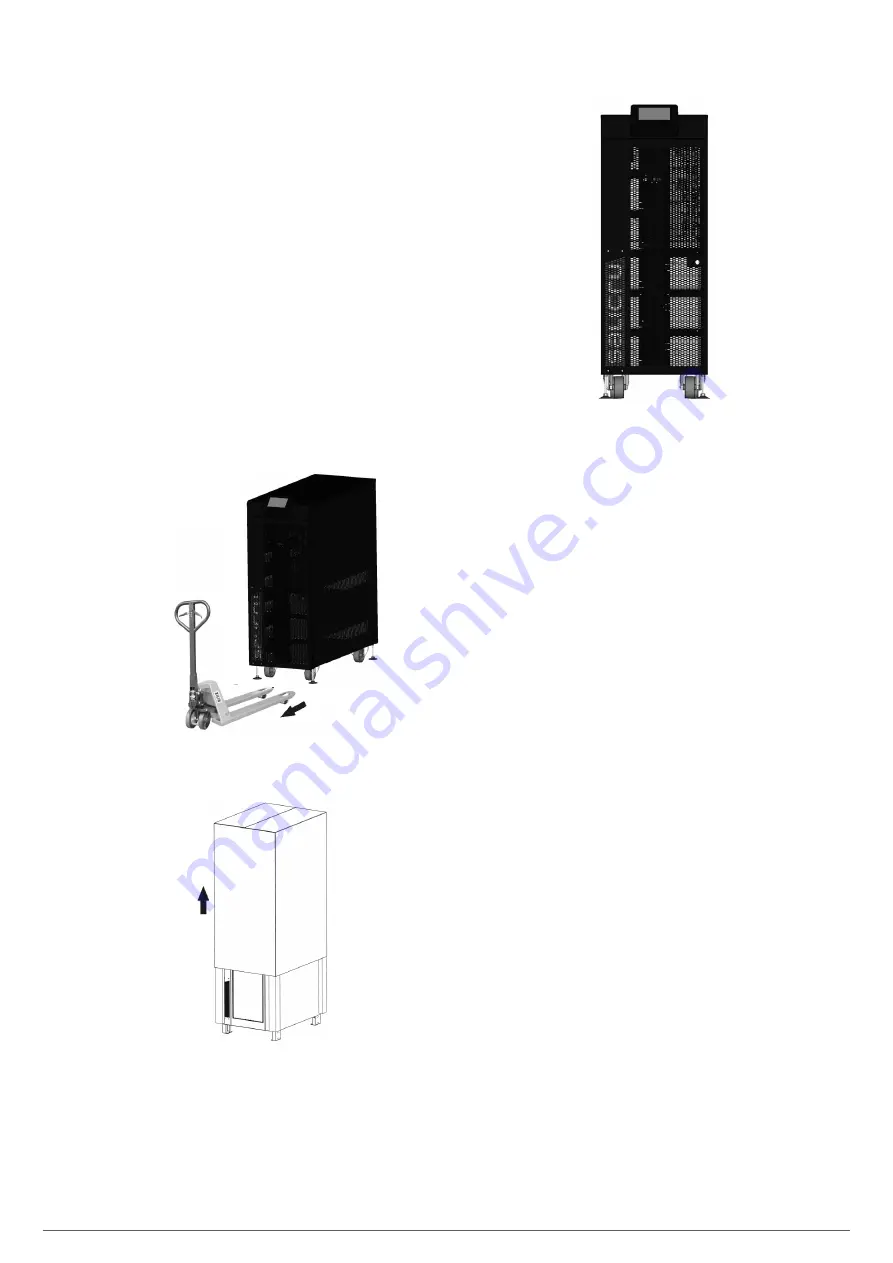
28
SALICRU
Leave it in this mode for at least 12 hours.
Once the batteries have been charged, stop the unit,
disconnect it electrically and store the UPS and the bat-
teries in their original packaging, noting the new date
of recharge of the batteries in the box on the label (see
Fig. 20
).
The units that form part of a parallel system will be
treated as individual units for charging the batteries,
and therefore no additional connection is necessary.
5.1.3. Unpacking
•
The unit's packaging consists of a wooden pallet, cardboard
or wooden packaging, as applicable, expanded polystyrene
(EPS) or polyethylene foam (EPE) corner protectors, polyeth-
ylene cover and strips, all recyclable materials, so if you do
dispose of them, you should do so in accordance with current
laws. We recommend that you keep the packaging in case
you need to use it in the future.
•
By way of example,
Fig. 21
Fig. 21
to
to
Fig. 23
Fig. 23
show illustrations cor-
responding to the 30 kVA or 40 kVA UPS cabinet.
Fig. 21.
Example of the unpacked SLC CUBE4 being moved
using a pallet truck.
Fig. 22.
Example of cardboard packaging being removed.
•
To unpack the unit, cut the strips around the cardboard pack-
aging and remove it upwards as if it were a cover (see
Fig.
21
and
Fig. 22
), or remove it using the necessary tools if it
comes in wooden packaging; remove the corner protectors
and the plastic cover.
Fig. 23.
Example of an unpacked unit.
5.1.4. Transport to the site
•
If the reception area is far from the installation site, it is
recommended to move the
SLC CUBE4
using a pallet truck
or another more suitable means of transport, assessing the
distance between the two points, the unit's weight, the
characteristics of the area to be crossed and the site (floor
type, floor resistance kg/m
2
).
•
However, when the distance is considerable, it is recom-
mended to move the unit in its packaging to the vicinity of
the installation site and then unpack it.
5.1.5. Siting, immobilisation and considerations
5.1.5.1. Siting for single units
• By way of example,
Fig. 24
shows configurations composed
of a single UPS cabinet: a UPS with batteries inside, a UPS
with an external battery cabinet and a UPS with extended
autonomy with two external battery cabinets.
To correctly ventilate the unit, it is necessary to en-
sure its surrounding area is free of obstacles. Observe
the minimum distances indicated in the table in sec-
tion 1.2.1 of document EK266*08 (Safety instructions),
which indicates the values for dimensions A, B, C and
D according to the power of each unit.
For battery cabinets, keep the same distances as for
the UPS, which are configured by the system.
It is recommended to leave an additional 75 cm free on
the sides for any service interventions (T.S.S.) or the
required clearance for the connection cables to allow
the unit to be moved forwards.
For extended autonomy with more than one cabinet, it is
recommended to place one on each side of the unit, and in
the case of a greater number of battery cabinets, to repeat
the same sequence alternately.
Summary of Contents for SLC CUBE4
Page 1: ...30 80 kVA USER MANUAL...
Page 66: ...66 SALICRU...
Page 67: ...67 SLC CUBE4 UNINTERRUPTIBLE POWER SUPPLY SYSTEM USER MANUAL...
Page 68: ...68 SALICRU...
Page 69: ...69 SLC CUBE4 UNINTERRUPTIBLE POWER SUPPLY SYSTEM USER MANUAL...
















































